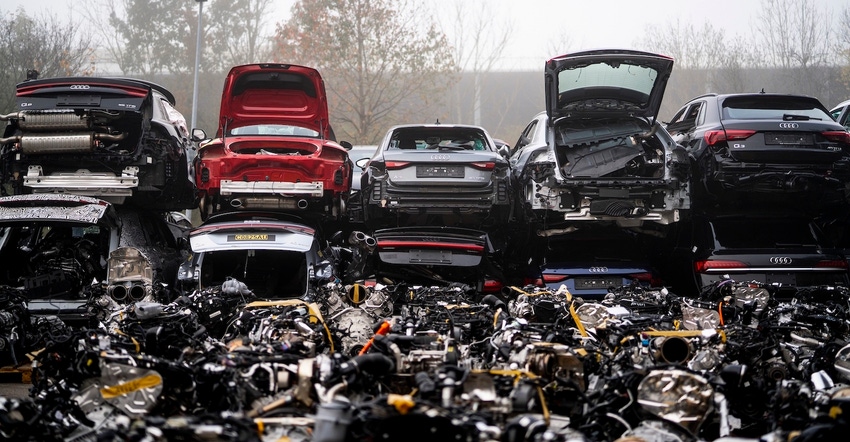In partnership with suppliers, recyclers, and researchers, the automaker is investigating ways to close the loop on materials such as plastic, steel, aluminum, and glass.
March 9, 2023

German automaker Audi and its supplier partners are working together through the MaterialLoop project to advance the circular economy in the automotive industry. Together with 15 partners from the research, recycling, and supplier sectors, Audi is looking into the reuse of post-consumer materials from the automotive sector for the production of new cars.
Until now, very few of the materials used in the production of new vehicles are recovered from old cars. Steel, for example, usually ends up in structural applications after end-of-life vehicle recycling. Audi wants to change that by reusing secondary materials taken from end-of-life vehicles in the production of new cars.
“The MaterialLoop project underscores our ambitious vision to operate a highly efficient circular economy concept for end-of-life vehicles,” said Audi CEO Markus Duesmann. “It is our goal to recover as many materials as possible at a high level of quality and reuse them in production. This will save valuable primary materials and lower the products’ ecological footprint. Simultaneously, direct access to secondary materials can contribute to increased security of supply. Raw materials would no longer have to be extracted.”
Back in October 2022, 100 vehicles, including former development cars, were dismantled as part of the joint MaterialLoop project. The targeted disassembly of individual components alone enabled the retention of high-quality secondary materials, such as larger plastic components, for recycling. After disassembly, the remaining car bodies were shredded and sorted into material groups comprising steel, aluminum, plastic, and glass. With the aim of testing the reuse of such materials in the production of new cars, Audi defined and piloted the recycling process together with project partners from the recycling industry, the Audi supply chain, and academia.
“Our emphasis on cycles within the industry enables us to use our products and the materials they’re made from for as long as possible. Our vision is to rely less on secondary materials from other industries in the future,” explained Johanna Klewitz, head of supply chain sustainability at Audi. Besides the technical feasibility of returning materials in the Audi supply chain, improving the ability of future generations of Audi vehicles to be recycled is also in focus. The project is part of Audi’s circular economy strategy and delivers valuable insights into implementing a circular economy in practice. Dennis Meinen, an expert for circular economy at Audi, said: “At its core, the circular economy is about handling resources responsibly. Longevity, repairability, and, indeed, our products’ ability to be recycled are, thus, all in focus.”
Plastic, glass, and aluminum recycling
Audi wants to steadily increase the share of recyclates in the Audi fleet over the coming years. Audi's procurement department is pursuing the goal of establishing material cycles for automotive applications wherever it is technically possible and makes economic and ecological sense.
Audi is deeply involved in plastics recycling. Thanks to PlasticLoop, one of the brand’s three plastics recycling projects, Audi and plastics manufacturer LyondellBasell have established a process that employs chemical recycling for the first time to reuse mixed automotive plastic waste for the series production of the Audi Q8 e-tron.
Since 2017, aluminum has also been managed within a recycling circle at Audi and Volkswagen sites. Aluminum offcuts, which occur during production, are returned directly to the supplier. There, they are recycled to form aluminum sheets of the same quality that Audi then reuses in production. This saves precious primary raw materials and ensures the cars enter the use-phase with a better environmental balance.
Audi also began gathering knowledge on the recycling of used automotive glass in the spring of 2022. Car windows that are beyond repair are first broken up into small pieces and then sorted. The resulting glass granulate is melted down and turned into new plate glass for the automotive industry. In fact, the glass is already used in the production of the Q4 e‑tron.
Design for recyclability
Together with its project partners, Audi is gaining valuable information for the design and construction of future models. Besides improvements in sorting technology, design for circularity plays a decisive role in Audi’s efforts to optimize the recyclability of new generations of cars. This means that, as far as material selection, composition, and modularity are concerned, automotive parts and their components are to be designed in such a way that they can be sorted by material type during end-of-life recycling. To this end, Audi has been working with the Volkswagen Group to develop a guide for suppliers that explains how to design plastic parts that further increase the rate of recycling in automotive production.
About the Author(s)
You May Also Like




